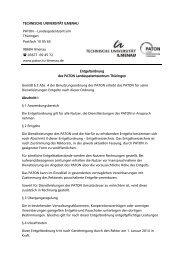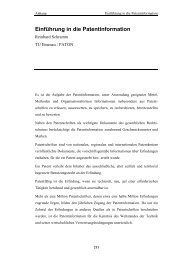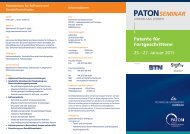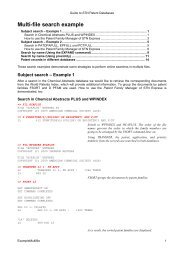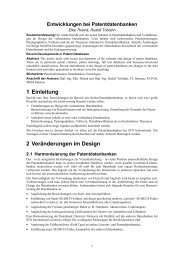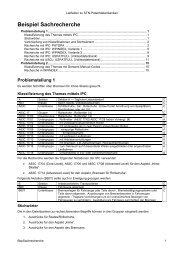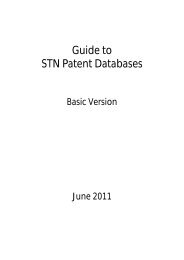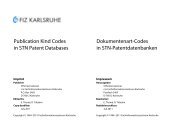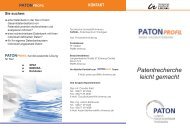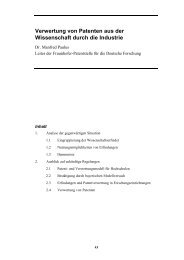Guide to STN Patent Databases – Basic Version - Paton - TU Ilmenau
Guide to STN Patent Databases – Basic Version - Paton - TU Ilmenau
Guide to STN Patent Databases – Basic Version - Paton - TU Ilmenau
Create successful ePaper yourself
Turn your PDF publications into a flip-book with our unique Google optimized e-Paper software.
Types of search<br />
US patent applications and US patents (US-A, US-A1, USB1/B2) from 1975<br />
PCT applications (WO-A1/A2) from 1978<br />
Japanese applications (JP-A) (Machine Assisted Translations) from 1975<br />
Australian applications (AU-A) from 2004<br />
United Kingdom granted patents (GB-B) since 2004<br />
Abstracts:<br />
German patent applications, patents and utility models (DE-A1, DE-B1/B2/B3/B4, DE-C1/C2 and DE-U1)<br />
from 2000<br />
European applications and granted patents (EP-A1/A2, EP-B1/B2) from 1978 for applications in English,<br />
from 2000 for applications in German or French<br />
Claims:<br />
US patent applications and US patents (US-A, US-A1, USB1/B2) from 1975<br />
PCT applications (WO-A1/A2) from 1978<br />
German patent applications, patents and utility models (DE-A1, DE-B1/B2/B3/B4, DE-C1/C2 and DE-U1)<br />
from 1968<br />
European applications and patents (EP-A1/A2, EP-B1/B2) from 1991 (1984 for EP-B)<br />
US patent applications and US patents (US-A, US-A1, USB1/B2) from 1993<br />
UK patents (GB-B, Derwent week 1984/09 <strong>to</strong> 1997/51 only)<br />
In the Derwent <strong>Patent</strong>s Citation Index only the title is available for text searching. It is recommended <strong>to</strong> do text<br />
and subject searches in the World <strong>Patent</strong>s Index and switch <strong>to</strong> the DPCI file for the citation search only.<br />
In INPADOCDB and INPAFAMDB the title (90% of all documents have titles, extensions <strong>to</strong> the title or original titles,<br />
TIO) and the abstract are available for searching. For most European languages it is entered in the original language,<br />
while for some non-European languages and Russian a translation in<strong>to</strong> English is made. Abstracts are entered for<br />
publications from 42 countries since 1970, i.e. from US, GB (since 1897), WO, EP, CA, DE, FR, CN. However, abstracts<br />
are not generally entered, but the number of the existing abstracts is considerable (> 13 million). The language of<br />
the abstract is often English, but other languages occur. Therefore, a (multi-lingual) text or keyword search in<br />
INPADOCDB should be made <strong>to</strong> complement, but not <strong>to</strong> restrict, a classification search.<br />
=> E A/FA<br />
**** START OF FIELD ****<br />
E3 0 --> A/FA<br />
E4 11807357 AB/FA<br />
E5 512650 ABDE/FA<br />
E6 101312 ABES/FA<br />
E7 1687006 ABFR/FA<br />
E8 263400 ABOL/FA<br />
E9 242928 ABOR/FA<br />
E10 52054682 AI/FA<br />
E11 52152990 AN/FA<br />
E12 48296890 DAV/FA<br />
The long-term coverage may be very helpful with some search problems.<br />
In INPAFAMDB the search indexes always cover the patent family. If two or more search terms are linked by AND the<br />
hits may come from several publications of the patent family. If this is not wanted (L) proximity must be used (see<br />
above).<br />
In the Chemical Abstracts database, the title and abstract are edited by the database producer. The words of the<br />
title, the abstract, and chemical indexing terms, including CAS Registry numbers, are searchable in the <strong>Basic</strong> Index.<br />
Searching is also possible with left-hand truncation. Single words from the abstract are additionally searchable in a<br />
specific /AB search field; the words of the <strong>Basic</strong> index excluding the abstract (i.e. only titles and index data) can also<br />
be searched in the /OBI search field.<br />
101



